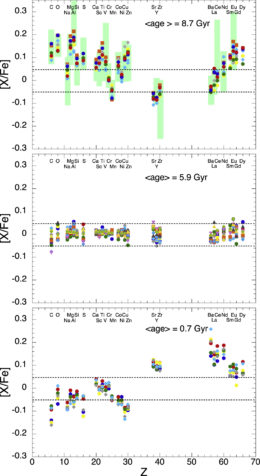Did you know that the Sun has a twin? Actually, it has a lot of them — solar twins are born all across the Milky Way. What can we learn about the chemical evolution of our galaxy from these stellar lookalikes?
Familiar Stars

Periodic table showing the origin of each chemical element. Those produced by the r-process are shaded orange and attributed to supernovae in this image; though supernovae are one proposed source of r-process elements, an alternative source is the merger of two neutron stars. [Cmglee]
In particular, solar twins provide a way to study elements that form mainly through the r-process: the rapid capture of multiple neutrons in a hot, dense environment. It’s not yet clear where these elements form — core-collapse supernovae were an early contender, but some astronomers now believe that neutron star mergers are the major source of these elements. These two processes differ greatly in their timescales: supernovae could generate r-process elements in just a few million years, while neutron star mergers would likely require billions of years. By tracking the abundances of r-process elements over cosmic time, astronomers can estimate how quickly these elements form — and what produces them.

Elemental abundances of solar twins in three age groups. Abundances are reported as the log of the ratio with respect to iron (e.g., if X/Fe = 10, [X/Fe] = 1.0). The green bars in the top panel show abundances measured in galactic bulge stars; the correlation suggests that the oldest solar twins originated in the bulge. [Tsujimoto 2021]
Heavy-Metal Patterns Revealed
In order to search for signs of r-process enrichment, Takuji Tsujimoto (National Astronomical Observatory of Japan) analyzed the elemental abundances of 79 solar twins with ages ranging from just 700 million years to 8.7 billion years. Tsujimoto measured the abundances of 28 elements — as light as carbon and as heavy as dysprosium — and found that solar twins of the same age showed the same chemical abundance patterns, but those patterns varied between different age groups.
Both the youngest and oldest solar twins showed signs of enhanced r-process elements compared to iron, while the middle-aged solar twins do not show this intriguing abundance pattern. What does this imply about the sources of r-process elements?
A Resurgent Source
To understand this pattern, Tsujimoto modeled the abundance of europium — an element produced almost exclusively through the r-process — as a function of time. Tsujimoto found that a two-population model was necessary to reproduce the abundance patterns seen in the data, meaning that there are likely two important sources of r-process elements — one that proceeds quickly, leading to enhanced abundances in the oldest twins, and one that proceeds slowly, leading to enhanced abundances in the youngest twins.
Tsujimoto found that a fast process like supernovae must play an important role in producing r-process elements, though a solely neutron-star origin isn’t out of the question; recently, models have predicted that a subset of neutron star binaries could merge in less than a billion years. For now, the mystery of the origin of r-process elements remains unsolved, though future investigations of distant neutron star mergers may crack the case.Citation
“Two Sites of r-process Production Assessed on the Basis of the Age-tagged Abundances of Solar Twins,” Takuji Tsujimoto 2021 ApJL 920 L32. doi:10.3847/2041-8213/ac2c75


